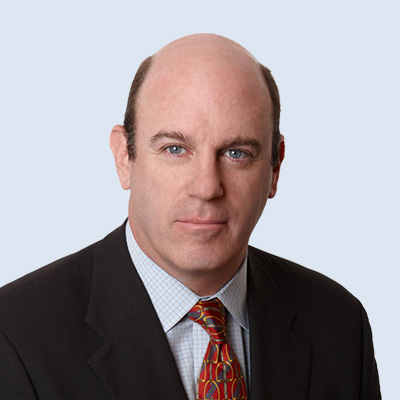Ted Grossman: Hi, I’m Ted Grossman. I’m a principal at the Alexander Group in our technology industry practice, here today to do an executive interview with one of our good friends, John Copeland, who is VP of Sales Strategy and Programs at Genesys. Nice to see you again. John, it’s interesting, I’m just looking at your title, and it used to have transformation in it, what happened?
John Coplen: Well, what happened is we’ve added several new groups into the team as well, right? So we tried to kind of broaden the name to kind of include other groups. So, you know, initially we led a lot of transformational groups, you know, in both our strategy and tools, but now we also have planning. We also have an RFP group. And so when we start adding in these other teams, we want to broaden out the name to kind of be a little bit more specific to the new groups that kind of join the team.
Ted Grossman: So no longer chief transformation officer more of a generic.
John Coplen: Yeah, more of a generic, although the transformation is still very much a part of what we do.
Ted Grossman: Well, I mean, that’s actually what we’re here to talk about because that’s what was in your title and that’s what actually what you do. I want to talk, first of all, a little bit more broadly about what you’re seeing in the industry. You work for Genesys, maybe just 20 seconds on what Genesys does, and then talk about some of the the key transformations that you’ve seen in the industry and some of the transformations that are going on at Genesys, if you can.
John Coplen: Yeah. Sure thing. So Genesys is the leading cloud provider of contact center solutions. We are a global company. We have business in every part of the world, very fast growing. We’re going through our own transformation over the last several years, moving ourselves from mainly an on-prem provider to being a cloud provider. And so that transformation has come with a lot of different challenges and opportunities as well. So what are we seeing in the market right now? In our specific market, prem is still the dominant tool.
Ted Grossman: On-prem, you mean on-premise software.
John Coplen: On-premise software, it’s still the dominant tool, but cloud is growing very fast and is very steadily, you know, attacking and gaining market share of the overall number of seats that you’d have in the market. So, you know, we’re a growing company, there’s a lot of opportunity. And the real changes are in that it’s how do we shift our models, how do we shift how we approach our customers? And how do we do that in a way that doesn’t cause any unnatural or, non-beneficial…
Ted Grossman: Unintended outcomes.
John Coplen: Unintended outcomes. Right. Because you don’t want to just shift right away and then cause more problems than you’re trying to solve.
Ted Grossman: Okay, I’m going to bring this back to basics, okay? Just for those who might be listening to this who doesn’t know what Genesys does really. Okay, you have a call center, may have a couple hundred people in it or a thousand people in there answering phones or doing outbound calls. They’re, you know, whether that be leads or, you know, doing transactions, whatever it might be. And of course, everybody has a headset on. They have a big communications desk in front of them. They probably have screens up about who they’re talking to. So you guys sell the software and systems that go into that, is that right?
John Coplen: Everything. Like when someone tries to contact a company, right, all the way to when they hang up. So we do everything that’s managed in between the routing getting the call, getting a text, getting even WhatsApp, digital, everything, straight to the right person. That person then triages whatever is the challenge or whatever it is that the customer needs, all the way to the end. So like you’re saying, we also are software also brings up who is the customer. What do they have? What are all the different things they’re looking for? What have they called about before? We also have a lot of AI tools that are kind of embedded in everything that we do. That makes it a much more efficient process for the customer.
Ted Grossman: It looks simple on the outside, but when you get in the inside, I know it’s very, very technical and very, very difficult. Lots of different systems, lots of different kinds of data and so forth. So you mentioned going to cloud, okay, and that’s a term that everybody kind of knows a little bit about, but you know when I think about it that’s kind of behind the scenes right? I mean a person in the call center doesn’t know what what the software is. They just know it comes up. Um, talk to me a little bit about what “going to cloud” is and not too technical. But then more importantly, why are you worried about unintended consequences? It seems like something that happens in the background in the tech side of the house. What’s important about it from a go-to-market perspective?
John Coplen: Well, so think about it as the way that our PNLs are constructed or most on-prem software companies, their PNLs are constructed over very long contracts that sell a bunch of hardware and other pieces up front. And then we have a lot of partners and ourselves that then maintain those software going forward. When you move to the cloud, that relationship of what we have with our customers, it’s different, right? Because now there’s not this hardware that’s maintained. There’s not this push of software down that have to be loaded onto those hardware systems. It’s all up in the cloud. So there’s not that hardware solution that kind of gets accompanied with it in the sales process. And then on top of that, when you’re in the cloud, you can start offering new upgrades, products, features, functionality much faster to our customers. So the relationship has to be much more continuous and ongoing and more proactive than in the previous on-prem world because it was much more of a slower transformation for those customers.
Ted Grossman: So fair to say, and you know, this might sound a little trite and a little overly simplistic, but in the old days, or when you were selling the on-prem, it was a big deal. You went in, you got the people who run the call centers to buy this thing. They bought it, they implemented it. Maybe they had a support contract or something, but that was pretty much it. Now it’s like continuous contact with them. You’re constantly pumping new features in maybe trying to get them to use it, maybe trying to get them to use more and then in which case you can charge more. Okay. So tell me a little bit about like some of the kinds of transformations that are going on. Like give me some examples of how is this affecting, you know, the job roles, how is this affecting anything that might happen in a normal sales force? It sounds like it’s you’re going from a, hey, I sold something, I move on to I sold something, I’m sticking with you kind of thing, but tell me.
John Coplen: Yeah, that’s a really good, good, good way to think about it, is that it’s much more of a: I’ve sold something now I need to stay and I need to continue to help my customer understand what are the new features I’m getting. You know, a lot of people are talking about all the different AI that’s out there, right? And AI is just layered in. And so you have to talk with your customer, hey, you should be using this. You should be doing that. What are the different new AI features that are coming and how should they be using those are AI features to improve their efficiency, how they get more value out of the tool? So the roles of our sales people is no longer more a one deal move away for 10 years. It’s a deal. You come back in six months, hey, there’s some new stuff we want to show you or maybe a year later – hey, we want to talk about some other things as well. And so it becomes more of a relationship that you’re building and you’re supporting your customer as you move forward.
Ted Grossman: Does this mean, like, if I’m just thinking of myself as a sales rep in the old days, I might have worked on, I’d have a couple of deals in my pipeline, I’d be working on them. Then I sell some, some don’t close. I move on to the next. Does it change how many accounts I have? I mean, it feels like I’m going to have to spend more time with accounts ongoing. Does that mean I have less accounts? And I’m going to be much more responsible for driving the growth of those accounts?
John Coplen: Yeah it does. It’s less accounts. It’s also more like you may have less accounts, but I don’t think it means that you’re less busy or you have less things to do. It’s just it changes the way that you would approach each one of those accounts. Whereas before you may have a very large territory with a lot of accounts, you may have like 2 or 3 deals going on, but when the cloud world. right, it’s less accounts and there’s much more active interactions and engagement with your customer.
Ted Grossman: So I know, you know, I’ll lead the witness here a little bit. You know, if you think about in traditional old school software, you sold it – there was an implementation team, there were support teams that came in, they took over and they had their roles. But now you’re talking about the sales team, which is probably the sales person, maybe you have some technical, presale, sales engineers, things of that nature. You know, how does that work? Because now you have a lot of people talking to the customer on a continuous basis. I’m assuming the post-sale people didn’t go away. So how do you manage the engagement there? How do you not confuse the customer?
John Coplen: It’s all about collaboration within the team, right? What people would call maybe a pod system or something like that, but it’s all about the collaboration that the lowest level, the front line workers, the front line AEs, you know, your individual contributors, you know, aligning on what is it that the customer needs? How should we be going as a united front to the customer? How should we be talking to the customer about all the different things that are happening with Genesys? You know, and so that’s kind of another one of those big, big changes. Because you’re right, in the past it was like big sales handed off to our post-sales. Post-sales does a great job of deploying and keeping the customer happy with the product. But now with the way that things operate more in the cloud you have to be more on top of what the customer has and what the needs are. The barriers too, to change or to shift to another provider also very high. So you have to continually be providing that value to the customer so that they understand the value they’re getting from your tool.
Ted Grossman: Yeah. I mean it sounds like a lot more teamwork. It sounds like the roles have changed so fundamentally. Does this have an impact on company culture?
John Coplen: It does. But I think in the positive, right? Because I think what it does is it kind of pushes everyone together to have to collaborate to find success, right? So it does change the culture, but I think for us, it really has been a positive in that we’re all collaborating much closer and working together, whether it’s marketing, sales post-sale, CS, all our different organizations, we work much more closely together.
Ted Grossman: It sounds like there’s a strategy and your job is to come up with the strategies are. But whenever I talk about cultural change and things change, even if it’s for the positive, that’s some of the hardest things, because you’re telling people who did something for a long time one way, you now have to collaborate with people in a different way. Maybe that means some of the cheese is being moved around. I used to do this and now somebody else is doing it. How much of this is coming up with the right strategy and how much of this is change management?
John Coplen: It’s a combination of strategy and change management. The strategy is understanding – these are the roles we had and this is what they did. In the future state, this is the roles that we need, and here’s what we need people to do in the future state. So the strategy is defining what those roles are and the future state and moving yourself towards that. And there’s a cultural piece to that because a lot of those jobs that, you know, you still need the same types of skill sets on this side, maybe a little bit in more expanded capacity, but when you shift those over there is that, that piece of change management that is needed to help those people understand, like, look, it’s not that we’re saying what you were doing is not useful, it’s that it’s we’re moving to the future. This is what you really need to do.
Ted Grossman: And where I was going with the question is, how much of your time do you actually spend coming up with the new ideas and using the strategy piece of your title, versus the no cajoling and training and enablement of the teams?
John Coplen: It’s interesting you say that because you can come up with a strategy, right? And that seems I wouldn’t say that’s the easy part because it’s difficult. There’s a lot of thought that goes into it. But the the socialization of that, the buy in that you have to get from top to bottom, that takes a lot of time. Right? You know, successful transformations in my opinion, have three key things that that happen. And one is that you have leadership bought in and understanding what the scope and the expectations are. You know, the second thing is a really, really clear timeline guide path, expectations, scope going forward. And then the last thing is just you have to have the organization, the will to do it. And what I mean by that is like, you’re going to run into a lot of, you know, people that will say ‘no’ on top and bottom, all across the organization. You have to have like just the intestinal fortitude of the organization to just like, yes, we understand this is uncomfortable, but we’re going to go ahead and do this. In the past year, we had a couple of big changes at Genesys. And, I’ve been really the leadership that we’ve had during both of those changes were very much – I understand this is difficult, but this is the direction that we need to head, so we’re going to go there. Its been a year out, six months out from a couple of the bigger changes it’s been the right direction. It’s where we needed to go. And it’s just so important. But I guess to your question is the decision is kind of like you can make the decision right, and you can come up with the strategy. It’s the – how do I now get everyone to kind of pivot and change into a certain direction and start marching towards the new vision or the new strategy?
Ted Grossman: Well, I love your comment about intestinal fortitude. I like the three areas that you pointed out. I know, this has been great because I think in a very short time you’ve given us some big hints about how you guys are doing it and, so a little bit of a framework to think about. So I want to thank you for your time today and look forward to having future discussions with you.
John Coplen: Thanks, Ted. Yeah.





